The title says it all: “TAPPED 9: Artists and their Professors.” In this ninth iteration at Manifest Gallery, there are seven pairs (the teacher is listed first):
Elvia Perrin, Austin, TX, and Lauren Cardenas, Taylor, MD
Thad Duhigg, Worden, IL, and Scott Ross, McMinnville, OR
Michael Reedy, Ann Arbor, MI, and Lorena Ganser, Ann Arbor, MI
Kevin Muente, Erlanger, KY, and Tyler Griese, Park Hills, KY
Terry McKelvey, Erie, PA, and Brad Milligan, Easton, MD
Karen Hillier, Bryan, TX, and Michelle Robinson, LA
William Cannings, Lubbock, TX, and Jon Whitfell, Slaton, TX
They were selected from 256 pieces by 92 artists from 27 states and Canada. The concept behind the exhibition suggests the connection between professor and pupil is not necessarily visual, but that the students “carry our professors’ voices forward in time as we mature as artists and people. … We realize that the learning they inspired is a chain-reaction process that develops across our lifetime,” according to material provided by Manifest.
That thesis is difficult to illustrate. It is easier to look for visual connections expressed in style, subject, materials, techniques, compositional strategies, and/or sensibility, with the hope/expectation that the student will absorb what the teacher has to offer, and, indeed, carry it forward. It’s disheartening when the student adopts wholesale the teacher’s aesthetic and adds nothing new, as is the case in Elvia Perrin’s and Lauren Cardenas’s black-and-white intaglio prints that are virtually identical.
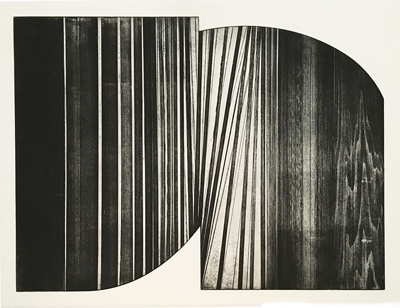
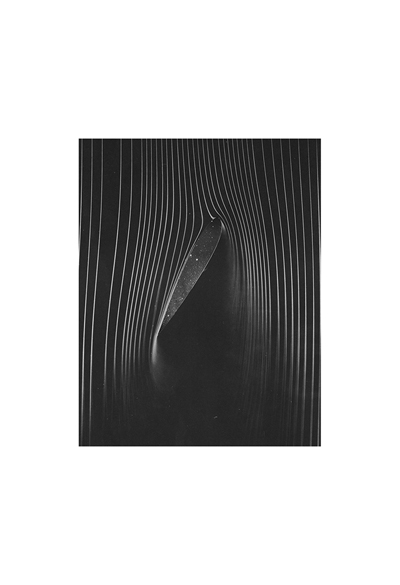
I can make sense of most of the pairings, but I am completely flummoxed by Thad Duhigg and his student Scott Ross. Did someone mistakenly install them in this gallery?
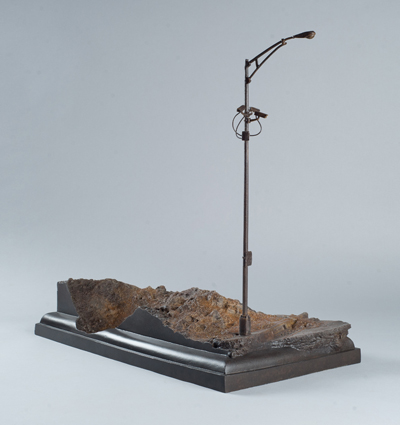
Duhigg’s lyrical cast-bronze Presence evokes Giacometti’s elongated bronze figures striding across empty plazas and conveys the same melancholy feeling.Ross’s brutish fired-clay Pagodawith its smashed-together forms could have come out of Peter Voulkos’s studio.
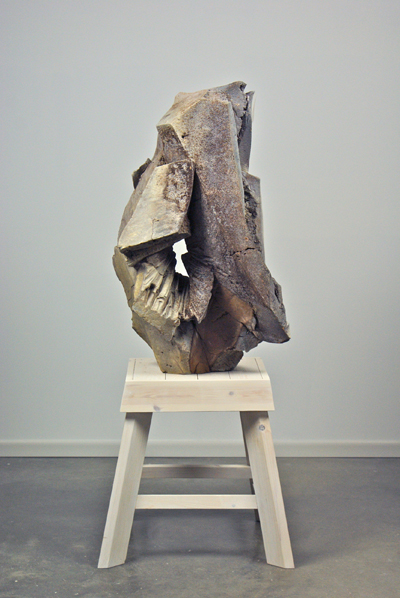
Checking the dates of execution only reinforced my feeling that they did not belong in this show since Ross’s Pagoda predates his prof’s Presence by seven years.
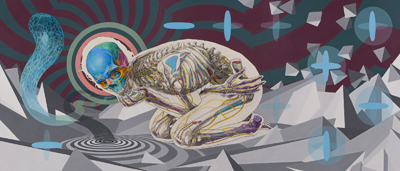
More at home here are Michael Reedy’s Moonshine and student Lorena Ganser’s Joke’s on You.Reedy presents the profile of a skeleton in the pose of a supplicant on the “floor.” Reedy has placed this macabre figure against a background of spirals, pyramidal shapes, elongated ovals, stripes, crosses shaped like children’s jacks, a stylized cobra (very stylized), etc. It’s easy to mentally excise the skeleton and fill the void with more abstract shapes, turning the work into a purely nonrepresentational painting.
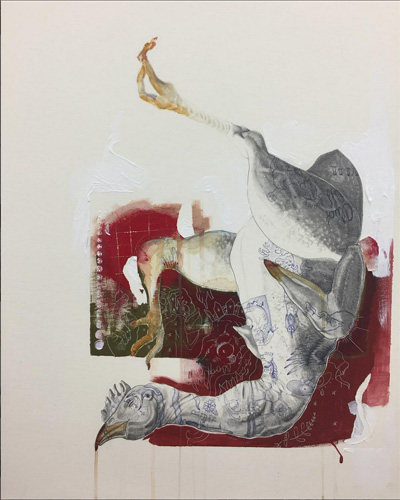
Flipping Reedy’s compositional strategy, Ganser has given the nuanced drawing of a plucked chicken the starring role. A blood-red backdrop focuses attention on the bird and offers no competition for it. All of this floats on a creamy background. For Reedy, the skeleton is incidental. For Ganser, the barnyard fowl is integral.
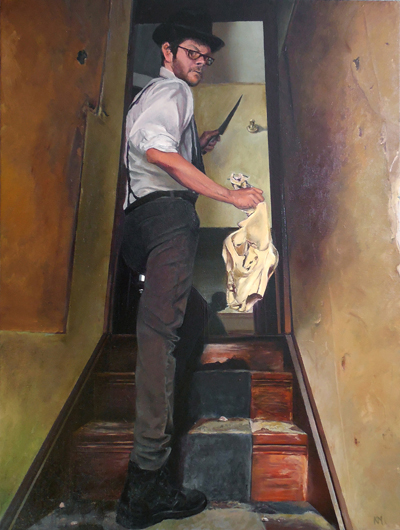
Kevin Muente’s Taxidermist is unsettling. A man wearing a hat ascends a staircase (from a basement?). He holds a long knife in in his left hand and what might be the skin of the animal he’s stuffing in the other. He has turned to confront the viewer, maybe daring him to follow.
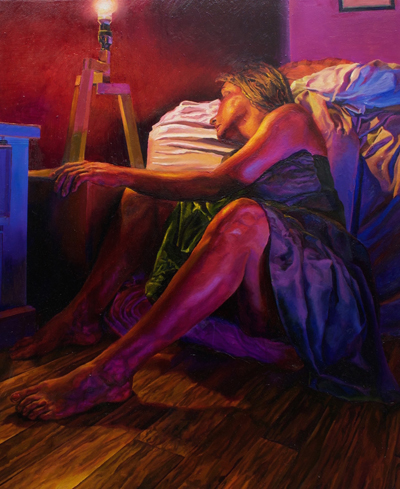
His student Tyler Griese’s Separationis also disturbing. His neon palette turns what could be an innocuous scene into a lurid one. A woman, wrapped in a purple drape and with her legs falling open, is asleep on the floor with her back leaning against a rumpled bed and her head and right shoulder resting on it. Her left arm is out-stretched, and her hand rests on a cube. It takes effort for it to stay there, raising the question of “Is she is truly asleep?” Behind the cube is an odd-looking standing lamp of nailed-together wood pieces with a bare bulb that illuminates the scene. What seems at first look a simple scene becomes mysterious because of Griese’s palette in a minor key.
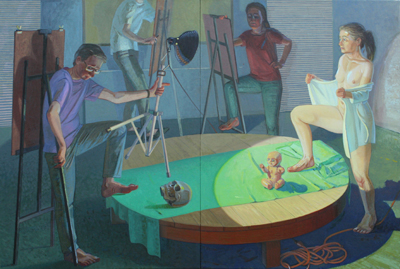
Terry McKelvey’s Presentiment and Brad Milligan’s Raise thee (yes, thee) Great Wallboth present studio scenes. McKelvey’s is set in a classroom (his?), and Milligan focuses on a messy table with cans of paint, bottles, a scrap of cloth decorated with coffee cups, and all manner of things that might be found in a studio; it is veiled by a gauzy curtain.
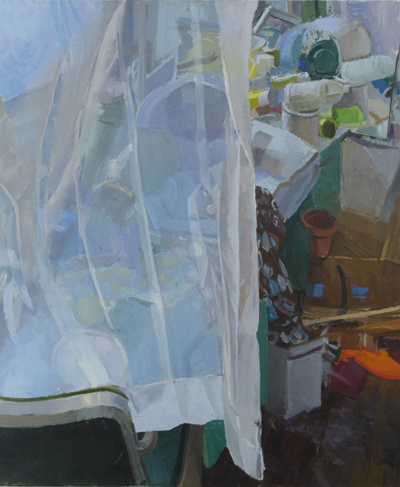
McKelvey has recorded the beginning of a life-drawing class as a nude female steps up onto a round platform to pose for the students arrayed around her, all standing at their easels.
Both are realists but Milligan’s brushwork is loose and expressionistic while McKelvey’s is unemotional.
Feminism ties together Karen Hillier and Michelle Robinson. Both revere traditional needlework, women’s work.
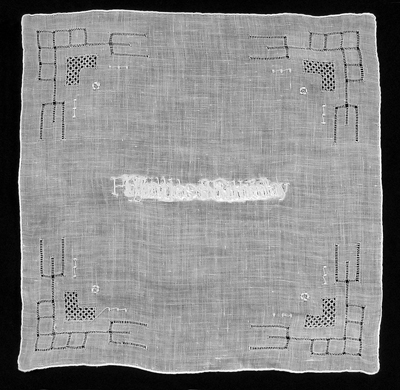
In Hillier’s Family Monogram, James Hillier, 1768, the artist has embroidered over the monogram of one of her male ancestors. She’s erased him but still honors the embroidery done by a female forebear. Its whiteness conjures up Robert Ryman’s monochromatic paintings.
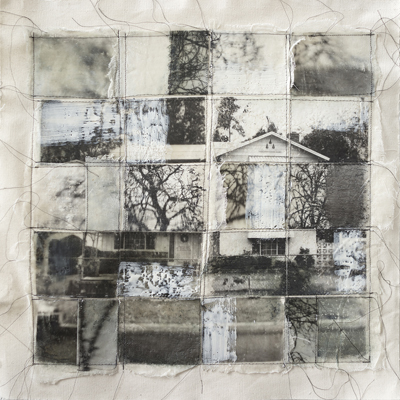
Robinson uses the traditional quilting technique of stitching together patches of fabric for the ground of Never a Silence; she could have more easily drawn a grid for the work’s organizing underpinnings. The quilting and loose threads reinforce the domestic nature of Robinson’s black-and-white photo transfers of what I see as middle-class suburban houses and the trees and yards that surround them.
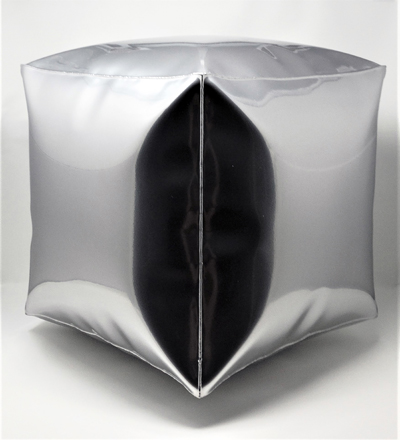
The only thing that connects William Cannings and Jon Whitfill, in my mind, is their retrograde tendencies. Cannings’ silver Cube recalls Andy Warhol’s 1966 Silver Clouds ofmetalized polyester film filled with helium. Warhol’s pillow shapes float, but Cannings’ Cube never will. He has a unique technique of heating flat steel and inflating it so the sculptureis anything but weightless and will never drift away.
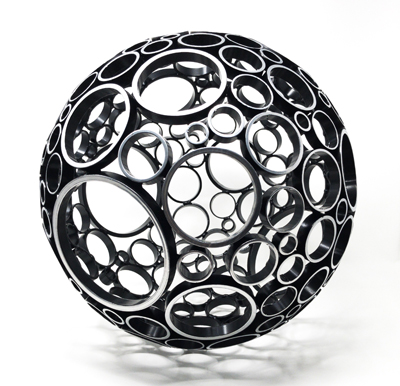
Whitfill also reaches back in time with Chrome and Matte. It’s a perfect sphere made up of circles of metal. It wouldn’t be out of place in a sculpture exhibition of the 1950s or 1960s.
The premise of the exhibition is worthy as it explores the nature of creativity seen through a lens of human relationships.
–Karen S. Chambers
“TAPPED 9: Artists and their Professors” through January 11, 2019. Manifest Gallery, 2727 Woodburn Ave., Cincinnati, OH 45206, 513-861-3638, manifestgallery.org